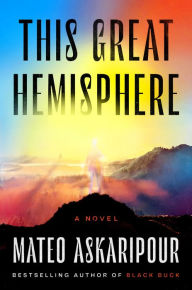Dedication to Detail: 5 Questions for Mateo Askaripour
Mateo Askaripour (A National Book Foundation 5 under 35 pick) follows up his NYT-bestselling Black Buck with something completely different – a strikingly unique dystopian science fiction novel steeped in political intrigue. Born from a true-life experience, This Great Hemisphere may take place in a distant future (500 years, to be exact), but this is not a future so distant that you can’t feel its presence in the modern world. We sat down with Mateo for a quick Q&A about his new book.
This Great Hemisphere: A Novel
This Great Hemisphere: A Novel
In Stock Online
Hardcover $29.00
A National Book Foundation 5 under 35 pick delivers a dystopian story with sci-fi flare and a political edge, featuring a terrific cast and a world both familiar and unsettling.
A National Book Foundation 5 under 35 pick delivers a dystopian story with sci-fi flare and a political edge, featuring a terrific cast and a world both familiar and unsettling.
You mention this idea coming from an experience you had on the subway. How did you cultivate that singular experience into such an expansive and imaginative story?
Yes, the short version is that a man and woman stepped onto the train. He asked her where she wanted to sit, and pointed directly at my stomach, as if my seat were free, and I wasn’t even there. I’d literally felt invisible, and that feeling stayed with me when I returned home that night. Instead of wallowing in it, I began to ask questions: What if there were actually a race of invisible people? How did they become invisible? Would the world revere them, or do its damnedest to subjugate, and even potentially annihilate, them? As I answered these questions, concrete characters started to form, vivid settings began to emerge. The book then became a means of taking control of a narrative instead of allowing a narrative to take control of me.
There are so many big details here, but the attention to detail for the “small” elements really stands out. The use of color in food, paint, people; names vs state names; colloquialisms like dippy and vizzers; why did you feel the need to be so intentional with these details, and what did you want them to accomplish?
The details, in the beginning, were a way of overcompensating for writing a futuristic novel. I thought that if I didn’t include the most minute details, the world and its characters wouldn’t feel real. Fortunately, my editor helped me realize that while details are good and necessary, they have to be meaningful details that aren’t filler or fluff, so that they ground the reader in the reality I’m presenting, even if this is fiction. I also naturally write in a style that feels cinematic, and this is often achieved through dedication to detail.
This novel is set 500 years in the future, and, naturally, the world looks a lot different. Mentions of plastics and the environment (bugs are extinct!) play a big part in the story, and there was even a war around it. How did you go about forecasting what the future would look like, as well as how the future would look back on our current time?
As I was drafting, I understood that the world I was writing about wasn’t so different from our own. I then had to ask myself, Why?, then, How? The novel soon became less speculative and more historical, which allowed me to use the past as a foundation for the future. I also tapped into current sentiments––feeling invisible, holding second-class citizenship in your own country—to serve as the novel’s emotional backdrops, so that these characters, living in completely different times, would still be relatable. When I hit my stride, it felt like I was holding up binoculars to a distant scene and writing down what I saw, rather than conjuring something entirely out of nothing.
Despite being set 500 years in the future, there is a big historical element, such as deep religious ties, forest communities, even some terminology—castles, for instance—but also the recurring detail that history is on a need-to-know basis in this future. Most people don’t know their history. What’s the importance of history to Candace, and the story as a whole?
I don’t believe that anything we’re experiencing now is new––in other words, history is cyclical. So if it’s cyclical, what can we do, if anything, to disrupt that cycle for the sake of progress? And even then, progress to one is decline to another. Throughout history, events, people, and places have been weaponized, withheld and distorted in order to support the story of those in power. We see this in the novel, and we certainly see it today. I wanted readers to recognize that, and then interrogate what that means for their own lives, as well as the future of our world and species.
This Great Hemisphere is a book with something to say, both about our current world, and the world of the future. How actively were you thinking of that message as you wrote, and how much were you just trying to tell a good story?
MA: My debut novel, Black Buck, was purposely laden with messages. For This Great Hemisphere, I first and foremost wanted to tell an engaging story full of captivating characters, but it’s nearly impossible for me to write anything devoid of existential angst and questions, so the challenge was to bake contrasting philosophies, worldviews, and visions for the future into the narrative, without it being a bunch of professorial, chin-scratching perspectives dressed up as a novel, because no one needs 400 pages of a PSA. At least, I don’t.
